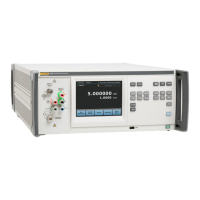5790B
Operators Manual
6-4
Table 6-2. Response Data Types
Data Type Description
Integer
Integers for some controllers or computers are decimal numbers in the
range from -32768 to 32767.
Responses in this range are labeled Integer.
Example:
CMD: *ESE 123; *ESE?
RESP: 123
Floating
Numbers that may have up to 15 significant figures plus an exponent that may
range from +/-E20.
Example:
CMD: CAL_CONST? FREQ_G
RESP: +1.000141377406621E+00
String
Any ASCII characters included within quotation marks
Example:
CMD: RPTSTR "Hello World"; RPTSTR?
RESP: "Hello World"
Character
Response
Data (CRD)
This type of response is always a keyword such as PPM, PCT, and RATIO.
Example:
CMD: DUNIT PPM;DUNIT?
RESP: PPM
Indefinite
ASCII (IAD)
Any ASCII characters followed by EOM. (EOM is an IEEE-488 bus message.)
Queries with this type of response MUST be the last query in a program
message.
Example:
CMD: *OPT?
RESP: WBND
CMD: *OPT?;*ESE?
RESP: <none>
ERR? = 1310,"488.2 Query After Indefinite Response"
CMDSTR? = "*opt?;*ese?\n"
CAL reports and lists which contains NEWLINE's
are typically of this type
Binary Block
Data
A special data type defined by the IEEE-488.2 standard. This type is used in
*PUD? query. It is defined as follows:
#(non-zero digit) (digits) (user data)
The non-zero digit specifies the number of characters that will follow in the
<digits> field. Characters allowed in the digits field are 0 through 9 (ASCII 48
through 57 decimal). The value of the number in the <digits> field in decimal
defines the number of user data bytes that follow in the <user data> field. The
maximum response is 64 characters.
Example:
CMD: *PUD "test1"; *PUD?
RESP: #40005test?

